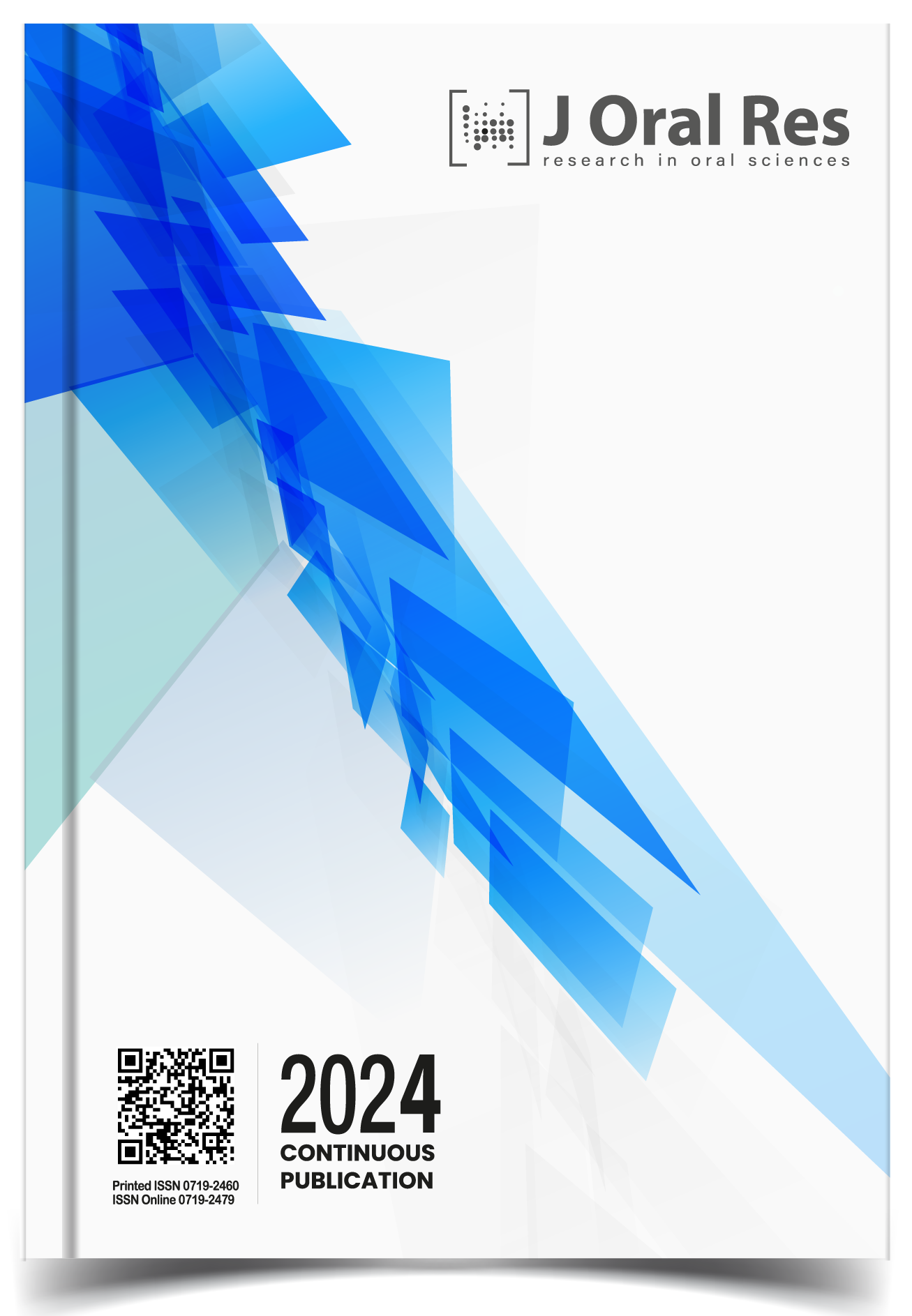A feasible in vitro method to evaluate bacterial infiltration in three implant-abutment connection systems
Resumo
Introduction: Microorganism infiltration through the im-plant-abutment interface causes oral health problems such as periimplantitis, leading to implant loss.
Materials and Methods: A feasible new method to quantify the Streptococcus mutans (S. mutans) infiltration through the implant-abutment interface gap is introduced in the present work. Internal hexagon (IH; n = 10), external hexagon (EH; n = 10), Morse taper (MT; n = 10), and a control for each group (n = 1) were tested. Bacteria suspension was prepared at 1.5x108 CFU/mL (CFU: colony forming units), and the implants were individually submerged up to the connection level, allowing the bacteria to contact it. The abutment was removed, and bacteria count was performed.
Results: The implant sets were tested under normal bacterial growth and early and late biofilm growth conditions. Colony-forming units per mL were obtained, and the results were compared among groups. Differences in bacterial count between the MT and EH (p<0.001) and the MT and IH (p<0.001) groups were significantly higher in the MT-type implant. There was a significant increment of bacterial infiltration in the MTs submitted to late biofilm growth conditions. EH and IH connections are more effective in preventing bacterial infiltration independent of the growth condition.
Conclusions: The proposed methodology is feasible to evaluate the infiltration of microorganisms through the implant-abutment interface.
Referências
Tallarico M, Canullo L, Caneva M, et al. Microbial colonization at the implant-abutment interface and its possible influence on periimplantitis: A systematic review and meta-analysis. J Prosthodont Res. 2017;61:233-241. https://doi.org/10.1016/j.jpor.2017.03.001. PMid:28359872
Canullo L, Penarrocha-Oltra D, Covani U, et al. Microbiologic and Clinical Findings of Implants in Healthy Condition and with Peri-Implantitis. Int J Oral Maxil Impl. 2015;30: 834-842. https://doi.org/10.11607/jomi.3947. PMid:26252036
Canullo L, Penarrocha D, Micarelli C, et al. Hard tissue response to argon plasma cleaning/sterilisation of customised titanium abutments versus 5-second steam cleaning: results of a 2-year post-loading follow-up from an explanatory randomised controlled trial in periodontally healthy patients. Eur J Oral Implant. 2013;6:251-60.
Quirynen M, Van Steenberghe D. Bacterial colonization of the internal part of two-stage implants. Clin Oral Implant Res. 1993;4:158-161. https://doi.org/10.1034/j.1600-0501.1993.040307.x. PMid:8297964
Quirynen M, Bollen CM, Steenberghe D. Microbial penetration along the implant components of the Brånemark system. An in vitro study. Clin Oral Implant Res. 1994;5:239-244. https://doi.org/10.1034/j.1600-0501.1994.050407.x. PMid:7640338
Hunt PR, Gartner JL, Norkin FJ. Choice of a dental implant system. Compend Cont Educ Dent. 2005;26:239-240.
Alves DC, Carvalho PSP, Martinez EF. In vitro microbiological analysis of bacterial seal at the Implant-Abutment interface using two Morse taper implant models. Braz Dent J. 2014;25:48-53. https://doi.org/10.1590/0103-6440201302178. PMid:24789292
Ardakani MRT, Meimandi M, Amid R, et al. In Vitro Comparison of microbial leakage of the implant-healing abutment interface in four connection systems. J Oral Implantol. 2019;45(5):350-355. https://doi.org/10.1563/aaid-joi-D-18-00311. PMid:31389766
D’Ercole S, Scarano A, Perrotti V, et al. Implants with internal hexagon and conical implant-abutment connections: an in vitro study of the bacterial contamination. J Oral Implantol. 2014;40(1):30-6. https://doi.org/10.1563/AAID-JOI-D-11-00121. PMid:22208157
Rismanchian M, Hatami M, Badrian H, et al. Evaluation of microgap size and microbial leakage in the connection area of 4 abutments with Straumann (ITI) implant. J Oral Implantol. 2012;38(6):677-85. https://doi.org/10.1563/AAID-JOI-D-11-00167. PMid:22047449
Bressan E, Stocchero M, Jimbo R, et al. Microbial Leakage at Morse Taper Conometric Prosthetic Connection: An In Vitro Investigation. Implant Dent. 2017;26:756-761. https://doi.org/10.1097/ID.0000000000000657. PMid:28945671
Guerra E, Pereira C, Faria R, et al. The Impact of Conical and Nonconical Abutments on Bacterial Infiltration at the Implant-Abutment Interface. Int J Period Restor Dent. 2016;36:825-831. https://doi.org/10.11607/prd.2779. PMid:27740643
Carinci F, Lauritano D, Cura F, et al. Prevention of bacterial leakage at implant-abutment connection level: an in vitro study of the efficacy of three different implant systems. J Biol Regul Homeost Agents. 2016;30:69-73.
Barnabé M, Saraceni, CH, Dutra-Correa, M, et al. The influence of Brazilian plant extracts on Streptococcus mutans biofilm. J Appl Oral Sci. 2014;22(5):366-372. https://doi.org/10.1590/1678-775720140085. PMid:25466471 PMCid:PMC4245747
Jansen VK, Conrads G, Richter E. Microbial leakage and marginal fit of the implant-abutment interface. Int J Oral Maxillofac Implant. 1997;12:527-540.
Silva LC, Andrade CFC, Filardy AA, et al. Análise dos níveis das interleucinas tipo 10 e 1? ap ós aplicação da pasta de iodofórmio na região peri-implantar: estudo piloto. Braz J Periodontol. 2013;23:39-44
Larrucea Verdugo C, Jaramillo Núñez G, Acevedo Avila A, Larrucea San Martín C. Microleakage of the prosthetic abutment/implant interface with internal and external connection: in vitro study. Clin Oral Implants Res. 2014;25(9):1078-83. doi: 10.1111/clr.12217. Epub 2013 Jul 4. PMID: 23822097.
Kadkhoda Z, Amarlv Z, Eshraghi S, et al. Antimicrobial effect of chlorhexidine on Aggregatibacter actinomycetemcomitans biofilms associated with peri-implantitis. J Dent Res, Dent Clin Dent Prosp. 2016;10:176. https://doi.org/10.15171/joddd.2016.028. PMid:27651884 PMCid:PMC5025219
Huang L, Xu QA, Liu C, Fan MW, Li YH. Anti-caries DNA vaccine-induced secretory immunoglobulin A antibodies inhibit formation of Streptococcus mutans biofilms in vitro. Acta Pharmacol Sin. 2013 Feb;34(2):239-46. doi: 10.1038/aps.2012.145. Epub 2012 Dec 31. PMID: 23274411; PMCID: PMC4089030.
Bowen WH, Koo H. Biology of Streptococcus mutans derived glucosyltransferases: role in extracellular matrix formation of cariogenic biofilms. Caries Res. 2011;45:69-86. https://doi.org/10.1159/000324598. PMid:21346355 PMCid:PMC3068567
Krzy?ciak W, Jurczak A, Ko?cielniak D, Bystrowska B, Skalniak A. The virulence of Streptococcus mutans and the ability to form biofilms. Eur J Clin Microbiol Infect Dis. 2014 Apr;33(4):499-515. doi: 10.1007/s10096-013-1993-7. Epub 2013 Oct 24. PMID: 24154653; PMCID: PMC3953549.
Lee A, Wang H. Biofilm related to dental implants. Implant Dent. 2010;19:387-93. https://doi.org/10.1097/ID.0b013e3181effa53.
PMid:20881809
Mombelli A, Décaillet F. The characteristics of biofilms in peri-implant disease. J Clin Periodontol. 2011;38:203-213. https://doi.org/10.1111/j.1600-051X.2010.01666.x . PMid:21323716
Aloisie JP, Curcio R, Laporta MZ, et al. Microbial leakage through the implant-abutment interface of Morse taper implants in vitro. Clin Oral Implant Res. 2010;21:328-335. https://doi.org/10.1111/j.1600-0501.2009.01837.x. PMid:20074246
Tripodi D, D’Ercole S, Iaculli F, Piattelli A, Perrotti V, Iezzi G. Degree of bacterial microleakage at the implant-abutment junction in Cone Morse tapered implants under loaded and unloaded conditions. J Appl Biomater Funct Mater. 2015;13(4):e367-71. doi: 10.5301/jabfm.5000247. PMID: 26660625
Bittencourt ABBC, Neto CLMM, Penitente PA, Pellizzer EP, Dos Santos DM, Goiato MC. Comparison of the Morse Cone Connection with the Internal Hexagon and External Hexagon Connections Based on Microleakage - Review. Prague Med Rep. 2021;122(3):181-190. https://doi.org/10.14712/23362936.2021.15. PMid:34606430
Subramani K, Jung RE, Molenberg A, et al. Biofilm on dental implants: A review of the literature. Int J Oral Maxillofac Implant. 2009;24:616-626.
Copyright (c) 2024 Alexandre Cavalcante de Queiroz, Ivana Barbosa Suffredini, José Dimas de Oliveira, Jefferson de Souza Silva, Eduardo Fernandesc Bondan

This work is licensed under a Creative Commons Attribution 4.0 International License.
This is an open-access article distributed under the terms of the Creative Commons Attribution License (CC BY 4.0). The use, distribution or reproduction in other forums is permitted, provided the original author(s) and the copyright owner(s) are credited and that the original publication in this journal is cited, in accordance with accepted academic practice. No use, distribution or reproduction is permitted which does not comply with these terms. © 2024.











